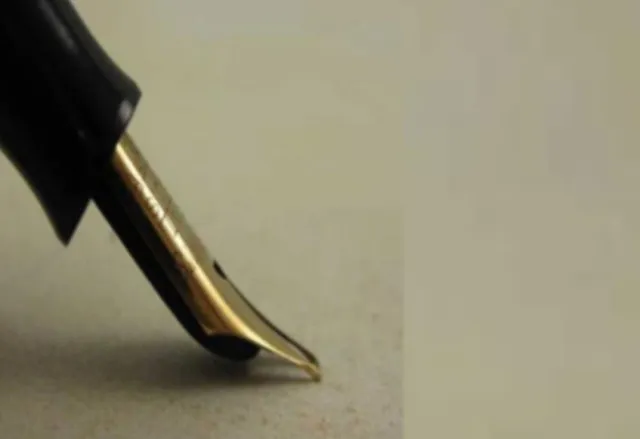In courtrooms across the globe, there is a poignant and symbolic tradition observed when judges sentence someone to death: they break the nibs of their pens after signing the final order. While it may seem like a simple gesture, this act carries deep significance, symbolizing the finality of the decision and the profound weight of the responsibility that accompanies capital punishment. In recent years, more people have begun to understand the meaning behind this custom, which is steeped in history and symbolism.
The Origin of Breaking Pen Nibs in Capital Punishment

The tradition of breaking a pen after sentencing someone to death has ancient roots. Historical accounts trace the origins of this practice back to the Mughal era in India. During this period, Mughal emperors would break their quills after signing death sentences as a way to symbolize the finality and irreversibility of their decision. The broken quill represented that the decision could not be undone and that no other command could be written with the same pen.
As time passed, colonial judges in India adopted the custom, and it became ingrained in the legal culture of the country. Even after India gained independence, the practice continued as a symbolic gesture in courts, emphasizing the weight and significance of sentencing someone to death.
Why Do Judges Break Pen Nibs After Sentencing Capital Punishment?
1. The Irreversibility of the Death Sentence
One of the most important reasons behind breaking the nib of a pen after issuing a death sentence is to emphasize the irreversible nature of the decision. Once a judge signs the death order, the act of breaking the pen serves as a reminder to everyone in the courtroom that this is a final and unchangeable act. Unlike other sentences that can be appealed, modified, or overturned, a death sentence carries a sense of finality that is unparalleled.
This gesture offers a moment of reflection for all present, from the judge to the court staff and the family members of the defendant. It underscores the weight of the decision, reminding everyone that a life will soon end based on the stroke of that pen. The broken nib becomes a symbol of this irreversible act, making it clear that the decision is permanent.
2. The Emotional and Ethical Burden on Judges
Sentencing someone to death is not just a legal decision—it is a profound moral and emotional responsibility. For many judges, the act of delivering a death sentence comes with a significant emotional toll. As much as the judge must follow the law, they also carry the weight of knowing that their decision will lead to the end of a human life.
Legal experts, such as Indian lawyer Subhash Ahlawat, explain that this tradition reflects the deep emotional burden that judges experience when imposing such severe punishment. Breaking the pen after signing the death order is a physical manifestation of the sorrow, regret, or internal conflict that a judge may feel. It acknowledges that, while they are bound to enforce the law, the decision weighs heavily on their conscience.
By breaking the pen, the judge also communicates that they are merely the instrument of the law, not personally responsible for the outcome. The law dictates the sentence, and the judge must carry it out, even if they harbor personal misgivings about capital punishment.
3. A Mark of Finality for the Pen Itself
In addition to the symbolism tied to the decision, breaking the nib of the pen also serves a more practical purpose: it ensures that the pen used to sign a death sentence will never be used for any other purpose. The act signifies that the pen, now marked by its role in ending a life, should not be used casually for other, less significant tasks.

This ensures that the pen itself is treated with respect, emphasizing the seriousness of the act it was used for. By breaking the nib, judges honor the gravity of their decision and reinforce the notion that the death sentence is not just another ruling—it is a matter of life and death. The pen, therefore, becomes a tool of finality, one that is discarded after completing its somber duty.
4. The Role of Symbolism in the Judicial System
Many legal traditions and customs rely on symbolism to convey deeper meanings, especially when it comes to matters of life and death. Breaking the pen is one such ritual, designed to offer a moment of solemn reflection in the courtroom. It is a reminder to judges, lawyers, and the public that the justice system is tasked with making decisions that carry immense consequences.
This symbolic act is a way for the judicial system to acknowledge the enormity of capital punishment. It reflects the recognition that decisions of such magnitude should never be taken lightly. In cultures around the world, rituals and symbols help people cope with significant moments in life, and the act of breaking the pen is no different. It allows judges to demonstrate the seriousness of their role and the impact of their decisions.
5. The Ethical Debate Surrounding Capital Punishment

As some countries move away from capital punishment, thepractice of breaking the pen has garnered even more attention. In places like the United Kingdom, where the death penalty has been abolished, this custom serves as a historical reference point, sparking conversations about the ethics of capital punishment and the burden placed on those who enforce it.
Even in countries where the death penalty is still legal, such as India, the tradition of breaking the pen remains a powerful symbol of the weight that judges carry when making such irreversible decisions. As societies continue to grapple with the moral implications of the death penalty, this small gesture serves as a reminder of the grave responsibility that comes with issuing a final sentence.
Conclusion: The Significance of Breaking the Pen

The act of breaking a pen nib after sentencing someone to death may seem simple, but it carries profound meaning. It symbolizes the finality of the decision, the emotional burden on the judge, and the seriousness of capital punishment. This tradition, rooted in centuries of history, serves as a reminder that the power to take a life is one of the greatest responsibilities the judicial system holds.
As more people become aware of this practice, it sparks important conversations about the ethical and moral implications of the death penalty. Whether seen as a reflection of the gravity of the law or a commentary on the role of judges, the breaking of the pen remains a poignant and meaningful symbol in courtrooms around the world.


